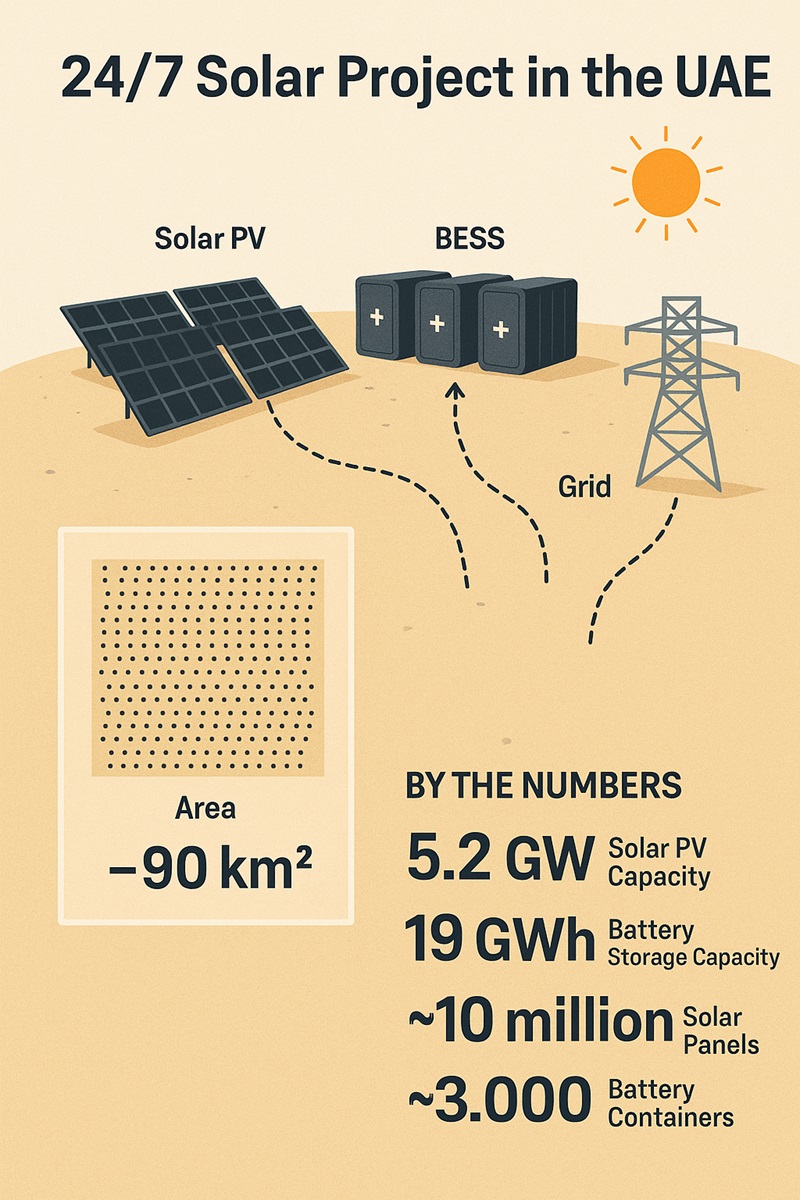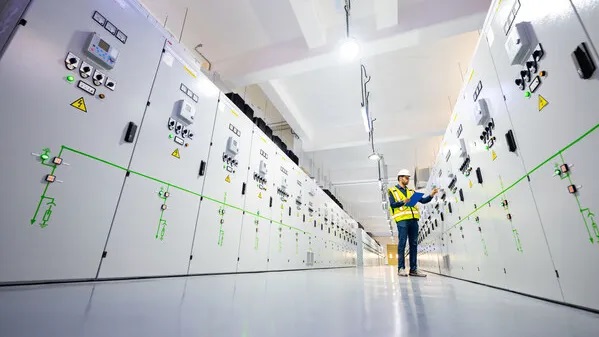In the desert outside Abu Dhabi, construction crews are breaking ground on a project that sounds almost like science fiction: a solar power plant that never sleeps.
For decades, the flaw in renewables has been obvious to even their strongest advocates. The sun sets, the wind stills, and suddenly clean energy needs backup. Fossil fuels, with all their costs to health and climate, have filled the gap. But what if that gap could be closed — not with gas or coal, but with sunlight stored in vast batteries beneath the sand?
That is the wager the United Arab Emirates is placing with what is being billed as the world’s first gigascale, round-the-clock renewable energy project.
A Solar Farm That Outlasts the Day
Unlike the sprawling solar parks already familiar across the Gulf, this facility is being built with one crucial addition: storage on a scale the world has never seen. 5.2 gigawatts of solar panels will capture the desert sun by day. 19 gigawatt-hours of batteries will hold that energy, releasing it through the night.
The promise is extraordinary: the equivalent of a full gigawatt of electricity, every hour of every day, clean and uninterrupted. Enough to light up cities, cool homes, and power industries without leaning on oil and gas.
The Technology That Makes Night-Time Solar Possible
The heart of the project is a battery energy storage system (BESS), built by global leader CATL. Solar panels make power only when the sun is out. The BESS captures extra energy in the day and releases it after sunset, turning sunlight into 24/7 power.

How It Works
- Generation – Panels make electricity in the day. Some flows straight to the grid.
- Storage – Extra energy goes into the BESS. It is stored in modular lithium-ion battery packs.
- Discharge – At night, inverters release the stored energy back into the grid.
- Grid Services – The batteries also keep the grid stable, just like fossil plants once did.
Why It Matters
- Scale – At 19 GWh, this system is far bigger than most in the world. (Many “large” BESS today are only 100–300 MWh.)
- Efficiency – Modern lithium-ion systems reach 90%+ round-trip efficiency, meaning most of the captured power is delivered.
- Desert Design – In Abu Dhabi’s heat, the batteries need strong cooling, insulation, and safety systems to avoid overheating.
- Long Life – Cycle management lets the batteries last for thousands of charge and discharge cycles.
Technical Annex
The Abu Dhabi 24/7 Solar Project blends massive scale with cutting-edge tech. Developed by Masdar and the Emirates Water & Electricity Company (EWEC), it combines:
- 5.2 GW of solar PV panels.
- A 19 GWh BESS.
Together, they will deliver 1 GW of nonstop clean energy—a global first. The site covers 90 km² of desert. Commercial launch is planned for 2027, with a total cost of about US$6 billion.
PV Field: Panels, Area & Layout
To reach 5.2 GW of power, the solar farm will install 8–10 million panels, depending on the final size of each module (500–600 W each). The farm will stretch across 90 km² of desert, looking like a sea of glass. Tracking systems will turn panels toward the sun for maximum power.
This layout makes sure there is enough power for the day and creates surplus energy for storage. That surplus is vital—it charges the batteries so power can continue at night. In the desert, dust is a major risk. To keep efficiency high, the site will need robotic or frequent cleaning systems.

Battery Energy Storage System (BESS)
At the heart of the project is a 19 GWh battery system, one of the largest in the world. Masdar has chosen CATL’s TENER platform.
- Each TENER unit is a lithium-iron phosphate (LFP) container.
- One container holds 6.25 MWh, while a new 9 MWh “Stack” will be ready in 2025.
- The project will use 2,100–3,000 containers, grouped in modular banks.
- Features include zero-degradation for five years, advanced cooling to survive desert heat, and grid-forming inverters that stabilize power like a regular plant.
This makes the BESS more than storage—it becomes an active grid partner.
Risk Focus for Decision-Makers
Despite its promise, the project comes with risks:
- Heat Management – Cooling in extreme desert heat adds cost and affects battery life.
- Battery Degradation – Even advanced chemistries age; replacements must be planned.
- Panel Dust – Without steady cleaning, dust could cut generation and reduce charging margins.
- Grid Integration – Supplying 1 GW of baseload from solar requires grid code updates, training, and new service rules.
- Supply Chain Scale – Moving and installing millions of panels and thousands of containers is a huge logistics challenge.
Addressing these risks will decide whether the UAE’s 24/7 solar project becomes a one-time success or a global model to follow.
Governments: A Roadmap to Energy Security
For leaders, the UAE project shows that clean power no longer needs fossil backup. A gigawatt of solar plus storage brings steady energy, stable prices, and less need for imported fuel.
The bigger lesson is policy. With the right rules, private money flows in. The $6 billion project is not charity. It is a safe investment with long-term returns.
Investors: A Market Ready to Scale
For investors, the message is clear: storage is the next big step in clean energy. This project proves that solar plus big batteries is no longer a trial but a real, investable asset.
Key points:
- Proven tech – Lithium-ion batteries now work at huge scale.
- Global model – Sunny regions from North Africa to South Asia can follow this plan.
- Carbon savings – Each gigawatt of clean energy cuts CO₂ and boosts ESG scores.
The Challenges Ahead
No project this large is without issues. Batteries in the desert must handle heat, dust, and long-term wear. Supply chains for minerals and parts must be secure. Cleaning panels and cooling batteries will shape costs.
But these are engineering problems, not barriers. The core idea is solid: solar energy can now run 24/7.
A Global Signal
This project is more than local success. It is a signal to the world: renewables can now be steady and reliable. With solar, storage, and smart controls, clean energy can be as dependable as coal or gas—without the emissions.
If it works, this project won’t just light Abu Dhabi’s night. It will light the way for every nation ready to replace fossil fuels with a cleaner, safer system.


